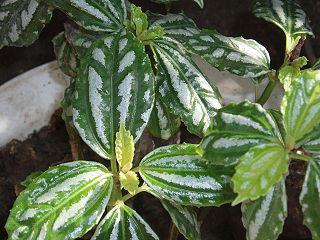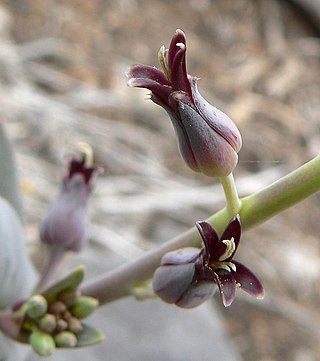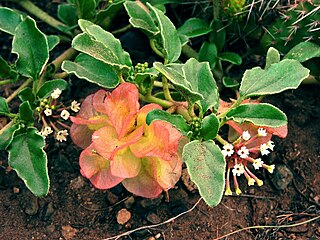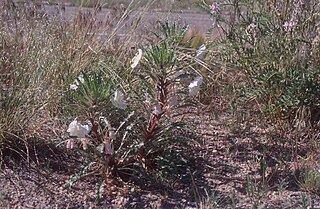
Stanleya is a genus of six species of plants in the family Brassicaceae known commonly as prince's plumes. These are herbs or erect shrubs which bear dense, plumelike inflorescences of white to bright yellow flowers with long stamens. Stanleya species are native to the western United States. These plants are toxic because they concentrate selenium from the soil in their tissues.

Pilea cadierei is a species of flowering plant in the nettle family Urticaceae. The species is endemic to the southern Chinese provinces of Guizhou and Yunnan, as well as Vietnam. The specific epithet cadierei refers to the 20th-century botanist R.P. Cadière. P. cadierei has earned the Royal Horticultural Society's Award of Garden Merit for its hardiness and reliability as a houseplant. In warmer countries, usually within USDA zones 8-12, the plant may be grown outside year-round as a perennial, either in-ground or contained, and pruned about 50% during the autumn.

Grindelia ciliata is a species of flowering plant in the family Asteraceae known by the common names Spanish gold, goldenweed, and waxed goldenweed.

Stanleya elata is a species of flowering plant in the family Brassicaceae known by the common name Panamint princesplume. It is native to the desert mountains of eastern California and western Nevada, where it grows in rocky and scrubby habitat types. It may also occur in Arizona. It is a perennial herb producing one or more erect stems reaching about 1.5 meters in maximum height. They are hairless and often waxy in texture. The thick, leathery leaves have lance-shaped or oblong blades with smooth or toothed edges measuring up to 15 centimeters long. They are borne on petioles. The top of the stem is occupied by a long inflorescence which is a dense, snaking raceme of many flowers. Each flower has four narrow, threadlike yellow or whitish petals each about a centimeter long and a millimeter wide. The fruit is a long, thin, wormlike silique which may be 10 centimeters in length. It contains tiny seeds.

Stanleya pinnata is a species of flowering plant in the family Brassicaceae known as desert prince's-plume. It is a perennial herb or shrub native to North America.
Streptanthus brachiatus is a species of flowering plant in the mustard family known by the common name Socrates Mine jewelflower. It is endemic to the Inner North Coast Ranges of California north of the San Francisco Bay Area. It can be found in chaparral and woodland habitat, often on serpentine soils, in Sonoma, Lake, and Napa Counties. It is a biennial herb producing a branching stem up to about 60 centimeters in maximum height. There is a basal rosette of fleshy purple-green leaves around the base, each with a sharp-toothed, widely lance-shaped blade up to 4 centimeters long. Leaves higher on the stem vary in shape. Flowers occur at intervals along the upper stem. Each has an urn-shaped calyx of keeled yellowish or purplish sepals just under a centimeter long. White, purple, or purple-veined white petals emerge from the tip. The fruit is a thin, narrow silique which may be up to 6 centimeters in length.
Streptanthus breweri is a species of flowering plant in the mustard family known by the common name Brewer's jewelflower. It is endemic to California, where it can be found in the coastal mountain ranges from the Klamath Mountains south to the San Francisco Bay Area. Its habitat includes chaparral and woodlands, usually on serpentine soils. It is an annual herb producing an erect, branching stem up to about 80 centimeters in maximum height. It is hairless except for fine hairs on some of the inflorescence parts, and it may be waxy in texture. The basal leaves have oval blades borne on petioles, and the lance-shaped leaves farther up the stem clasp it at their bases. Flowers occur at intervals along the upper stem, sometimes in a zig-zagging, one-sided array. Each has an urn-shaped calyx of keeled greenish or purplish sepals under a centimeter long. White, purple, or purple-veined white petals emerge from the tip. The fruit is a narrow, curved silique which may be 9 to 11 centimeters in length.

Streptanthus cordatus is a species of flowering plant in the mustard family known by the common name heartleaf twistflower. It is native to the western United States, where it can be found in many types of sagebrush, woodland, and forest habitat. It is a perennial herb producing a branched or unbranched stem up to about a meter tall. It is often waxy in texture. The basal leaves are oval or spoon-shaped with bristle-toothed blades borne on rough-haired petioles. Leaves higher on the stem are oval to lance-shaped, up to 9 centimeters long with their bases usually clasping the stem. Flowers occur at intervals along the upper stem. Each has a calyx of sepals roughly a centimeter long which begin greenish yellow and mature purple. Four purple petals emerge from the tip of each calyx. The fruit is a thin, narrow silique which may reach 14 centimeters in length or longer.

Streptanthus diversifolius is a species of flowering plant in the mustard family known by the common name variableleaf jewelflower, or varied-leaved jewelflower. It is endemic to California, where it is limited to the Sierra Nevada foothills. It is a resident of woodlands and other foothill habitat. It is an annual herb producing a hairless, waxy stem up to a meter tall. The basal leaves are variable in shape and are often divided into narrow, threadlike segments. Leaves higher on the stem are also variable, having round to lance-shaped blades which clasp the stem at their bases. Flowers occur at intervals along the upper stem, with one or two leaflike bracts at the base of the raceme. Each flower has an urn-shaped calyx of keeled sepals about half a centimeter long and white, yellowish, or purple in color, sometimes with white edging. White, purple-veined petals emerge from the tip. The fruit is a thin, flat, curving silique which may be 8 or 9 centimeters in length.
Streptanthus farnsworthianus is an uncommon species of flowering plant in the mustard family known by the common name Farnsworth's jewelflower. It is endemic to California, where it is limited to the woodlands of the Sierra Nevada foothills. It is an annual herb producing a hairless, waxy, purple or purple-tinged stem up to half a meter tall or more. The ephemeral basal leaves have blades up to 15 centimeters long which are each divided into several narrow lobes or leaflets. Leaves higher on the stem have purple lance-shaped blades that generally clasp the stem at their bases. Flowers occur at intervals along the upper stem with one or two leaflike purple bracts at the base of the raceme. Each flower has an urn-shaped calyx of purple sepals up to a centimeter long. Curling purple-veined white petals emerge from the tip of the calyx. The fruit is a straight or curving silique up to 12 centimeters long.

Streptanthus glandulosus is a species of flowering plant in the mustard family known by the common name bristly jewelflower. It is native to California and southwestern Oregon, where it grows in many types of habitat, including grassland, chaparral, and woodlands. Genetic and other analyses indicate that it is a species complex with ten subspecies which evolved as populations were isolated from each other. The complex includes subspecies previously considered separate species, such as the rare Tiburon jewelflower endemic to the San Francisco Bay Area. Plants in the complex are variable. In general they are annual herbs growing 10 centimeters to over a meter in height. They may be hairless hairy to bristly. The ephemeral basal leaves have blades borne on winged petioles. Leaves higher on the stem are linear to lance-shaped and clasp the stem at their bases. Flowers occur at intervals along the upper stem. Each flower has an urn-shaped calyx of sepals one-half to over one centimeter long which can be almost any color from white to yellowish to pink or purple to nearly black. Purple, white, or purple-veined white petals emerge from the tip. The fruit is a straight or curving silique up to 11 centimeters long.
Streptanthus gracilis is an uncommon species of flowering plant in the mustard family known by the common name alpine jewelflower.

Streptanthus longisiliquus is a species of flowering plant in the mustard family known by the common name long-fruit jewelflower. It was first described to science in 2007. It is endemic to northern California, where it is known from Butte, Tehama, and Shasta Counties. It can be found in forest and woodland habitat in mountains and foothills. It is a short-lived perennial herb producing a few-branched stem up to 1.2 to 1.5 meters in maximum height. It is mostly hairless except for some light hairs on the inflorescences and sometimes the leaf petioles. The basal leaves have oval or spoon-shaped blades up to 10 centimeters long, usually with smooth edges. Leaves higher on the stem are oval or oblong and lack petioles, their bases often clasping the stem. Flowers occur at intervals along the upper stem. Each flower has a bell-shaped calyx of sepals which yellow-green at the base and purplish at the tip, measuring under a centimeter in length. The petals emerging from the end are brownish or purplish with greenish bases. The fruit is a flattened, curving silique that can be quite long even for the genus, measuring up to 15 centimeters in length.

Streptanthus oliganthus is an uncommon species of flowering plant in the mustard family known by the common name Masonic Mountain jewelflower. It is native to western Nevada and eastern California, where it grows in the rocky hills east of the central Sierra Nevada. Its habitat includes forest, woodland, sagebrush, and mountain talus. It is a rhizomatous perennial herb producing a hairless, waxy, usually unbranched stem up to about 40 or 50 centimeters in maximum height. The basal leaves have lance-shaped, smooth-edged blades up to 10 centimeters long borne on fuzzy to rough-haired petioles. Leaves higher on the stem have shorter blades which may clasp the stem at their bases. Flowers occur at intervals along the upper stem. Each has a bell-shaped calyx of purple sepals no more than a centimeter long. The petals emerging from the tip are reddish purple or purple-tipped. The fruit is a smooth, flat, straight or slightly curved silique up to 8 to 10 centimeters long.
Tonestus eximius is a species of flowering plant in the family Asteraceae known by the common names Lake Tahoe serpentweed and Tahoe tonestus. It is native to the High Sierra Nevada, where it is known only from the vicinity of Lake Tahoe on the California-Nevada border. It grows in alpine and subalpine mountain habitat. It is a short, clumpy perennial herb growing up to 13 centimeters tall. The thick stems are hairless and glandular, the lower parts covered in the withered leaf bases of previous seasons' growth. The toothed or serrated leaf blades are up to 3 to 5 centimeters in length. The inflorescence is a single flower head or a cluster of a few heads. Each is 1 to 1.5 centimeters wide with green phyllaries. The head bears at least 10 bright yellow ray florets around a center containing many tubular disc florets.
Tripterocalyx crux-maltae is a species of flowering plant in the four o'clock family known by the common names Lassen sandverbena and Kellogg's sand-verbena.

Tripterocalyx micranthus is a species of flowering plant in the four o'clock family known by the common names smallflower sandverbena and small-flowered sand-verbena.

Streptanthus bracteatus is a species of flowering plant in the mustard family known by the common names bracted jewelflower and bracted twistflower. It is endemic to Texas in the United States.

Amphicarpum muehlenbergianum is a species of grass known by the common names blue maidencane, Muhlenberg maidencane, and goobergrass. It is native to the southeastern United States.

Oenothera harringtonii is a species of flowering plant in the evening primrose family known by the common names Arkansas Valley evening primrose and Colorado Springs evening primrose. It is endemic to the state of Colorado in the United States.















